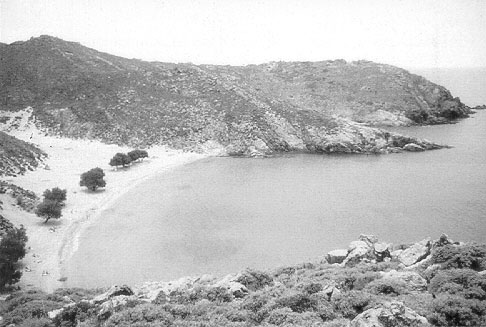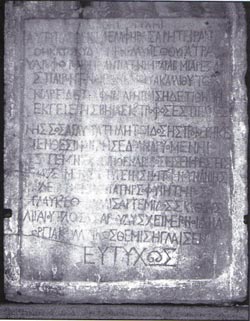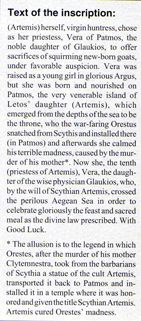An opinion piece I want to share.
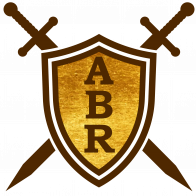 biblearchaeology.org
biblearchaeology.org
The King and I: Exiled To Patmos, Part 2
Second in a series on the Book of Revelation, this article examines the physical and historical evidence for the Aegean island of Patmos. The author draws from both ancient sources and his own exploration of the island to provide a greater understanding of the Book of Revelation.
 This article was first published in the Fall 1999 issue of Bible and Spade.
This article was first published in the Fall 1999 issue of Bible and Spade.
Second in a series on the Book of Revelation, this article examines the physical and historical evidence for the Aegean island of Patmos. The author draws from both ancient sources and his own exploration of the island to provide a greater understanding of the Book of Revelation.
A Misconception
A common misconception in commentaries and popular prophetic writings is that the island of Patmos, where John was exiled, was a sort of Alcatraz (Swindoll 1986:3) or St. Helene where Napoleon was exiled (Saffrey 1975:392). This is partly due to 19th-century travelers who described the island as “a barren, rocky, desolate-looking place” (Newton 1865: 223) or as “a wild and barren island” (Geil 1896: 70). Unfortunately, these 19th-century perceptions are not accurate in describing the island in John’s day.
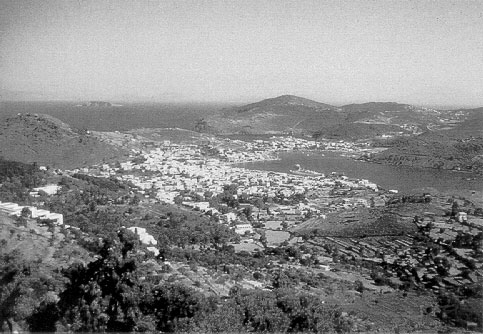
The island of Patmos (Rv 1:9). This small volcanic island sits in the Aegean Sea, 60 km (37 mi) from the Turkish coastal city of Miletus. Here the Apostle John was exiled and received his visions recorded in the Book of Revelation (sometimes called The Revelation of St. John the Divine). This view of the island is from the village of Chora to the northeast. In the center is the ancient and modern harbor, where the modern town of Skela is located. The ancient acropolis, known as Kastelli, is to the left.
First-century Patmos, with its natural protective harbor, was a strategic island on the sea lane from Ephesus to Rome. A large administrative center, outlying villages, a hippodrome (for horse racing), and at least three pagan temples made Patmos hardly an isolated and desolate place!
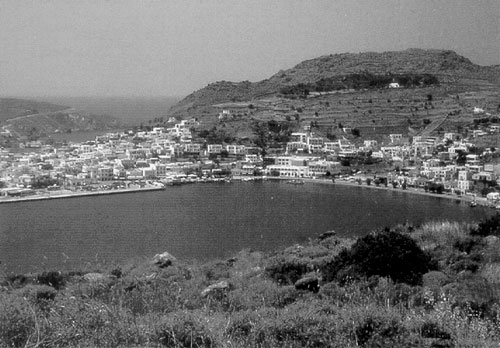
The harbor of Skela with the ancient acropolis (Kastelli) of Patmos to the right. Located on the sea lane between Rome and Ephesus, the harbor of Patmos was a regular and important stop along the line of communication and commerce between these two cities. Church tradition suggests John was exiled here from the city of Ephesus, where he had been serving as elder.
The 11 km (7 mi) long crescent-shaped island has a jagged 65 km (40 mi) coastline. Pliny the Elder (AD 23–79) knew the island, and in his Natural History said it was 48 km (30 mi) in circumference (Rackham 1989: 169). Central in the island and at its narrowest point is the Kastelli, the ancient administrative center. Called Skela today, it was located behind the harbor, and remains of its 1.2 m (4 ft) wide acropolis wall and three towers can still be seen (Tozar 1889: 194–95; Simpson and Lazenby 1970: 47-52). This center has a commanding view of the harbor, the sea lanes to and from Patmos and, I might add, spectacular sunsets!
Literary sources mention outlying villages on the island that probably engaged in fishing and agricultural activities. Of the three temples, one inscription mentions a temple to Artemis (Diana), the goddess of the hunt. Artemis’ main temple was in Ephesus, and known as one of the seven wonders of the ancient world. Patmos was probably located beneath the Monastery of St. John near the village of Chora. Threshold stones of the iconostasis (partition) in the Chapel of the Virgin may be remains of this temple.
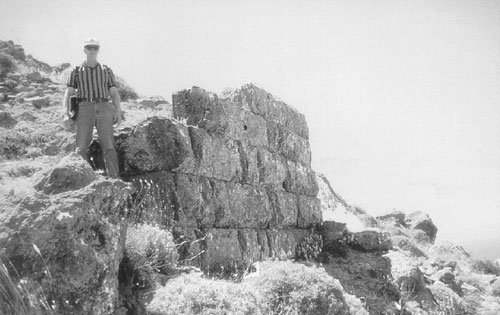
Five courses of stone from the ancient wall surrounding the acropolis at Patmos. From this administrative center, Roman officials had a commanding view of the harbor and sea lanes.
Literary evidence also speaks of a temple to Apollo, brother of Artemis, most likely located near the harbor of Skela. One 19th century traveler mentioned:
at the wharf I observed four or five beautiful white marble columns, cut and carved in true Greek fashion, and once very likely standing in the portico of some splendid temple to a heathen god, now used as mooring posts (Geil 1897:73).
Additional literary sources suggest the island’s third temple, dedicated to Aphrodite the goddess of love and beauty, was probably built on the Kalikatsou Rock along the Patmos shoreline.
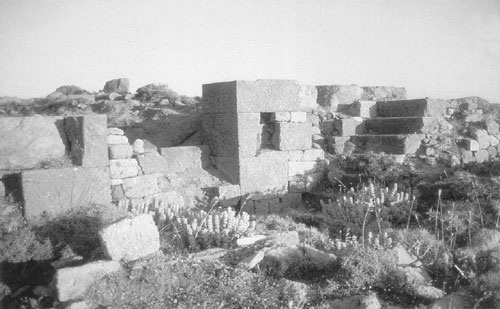
Remains of the northeast gate of the acropolis. John probably did not live in this area, which was reserved for military and governmental officials. Apparently free to move about the island, John probably resided in one of the outlying villages. Gordon Franz
A hippodrome on the island, known from inscription but not yet identified, was probably located near modern Skela. Using my sanctified imagination, I wonder if the Apostle John preached to the inhabitants of Patmos in this hippodrome?
Unfortunately, most tourists visiting Patmos today disembark at the port of Skela, hop a bus to the Cave of the Apocalypse, zig to the Monastery of St. John in Chora, zag to the harbor of Skela for shopping and eating before heading back to their cruise ship and out to sea. Yet, there are enough Biblically-significant sites on the island to make a serious student spend a couple of days.
Patmos has been described as a penal colony, like an ancient Alcatraz. Commentators refer to Pliny’s Natural History 4.12.69, yet it says nothing about a penal colony (Sanders 1962-63:76; Hemer 1986:221, n. 1). My impression is that John was exiled to Patmos because of its Artemis/Ephesus connections. The proconsul of Asia Minor wanted John out of Ephesus so he sent him to Patmos, also within his jurisdiction. Hemer suggests the island might be connected with Miletus, 72 km (45 mi) away (1986:28, 222, n. 8).
The length of John’s exile on Patmos differs from tradition to tradition. Most likely it lasted only 18 months, and upon Domitian’s death John was free to return to Ephesus. Dio Cassius wrote,
[Emperor] Nerva also released all who were on trial for maiestas (high treason) and restored the exile (Cary 1995:361).
Eusebius adds:
the sentences of Domitian were annulled, and the Roman Senate decreed the return of those who had been unjustly banished and the restoration of their property...the Apostle John, after his banishment to the island, took up his abode at Ephesus (Lake 1980:241).
Travels of St. John in Patmos
According to church tradition, the book Travels of St. John In Patmos was written by Prochorus (Acts 6:5), secretary to John. Critical scholarship suggests it was written in the fifth century AD. If it is historically reliable, John was only banished to the island, not imprisoned.
Travels of St. John in Patmos makes interesting reading. On the trip to Patmos, a violent storm arose and a passenger was swept into the sea. John prayed and a wave deposited the young man back on the boat. This miracle gave John opportunity to preach the Gospel. Once on Patmos, the Roman governor, Laurentius, set him free.
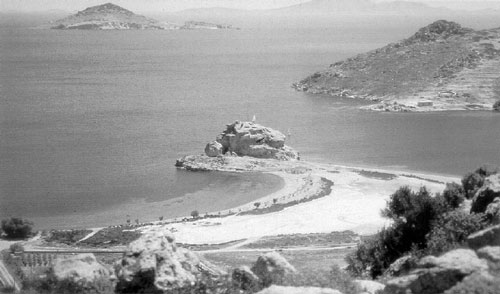
Kalikatsou Rock is the probable site of a temple to Aphrodite. Note nearby Aegean islands in the distance. John makes reference to these islands (Rv 6:14, 16:20). While called "the most sacred island" of Artemis (Diana of the Ephesians, Acts 19:28), the island housed three temples-to Artemis, her brother Apollo, and Aphrodite. Aphrodite was the goddess of love and beauty.
Laurentius’s father-in-law, Myron, offers the Apostle lodging in his house, and soon Myron’s house became the first church on the island. St. John healed Apollonides, Myron’s son, who was possessed with the devil, and this miracle led to the conversion of both Chrysippe, myron’s daughter, and her husband, the Roman governor (Meinardus 1979:7).
Also recorded in Travels of St. John in Patmos is a spiritual confrontation between John and Kynops, a famous magician on the island. John was victorious and Kynops drowned in the harbor. The event is commemorated by a church today (Meinardus 1979:9). Consequently, the people of the island turned to the Lord. Before leaving Patmos, John was asked by the believers to write an account of the life of the Lord Jesus. This was the Gospel of John according to one tradition. While the historicity of these accounts is in doubt, such freedom of movement on the island is hinted at in the book of Revelation.
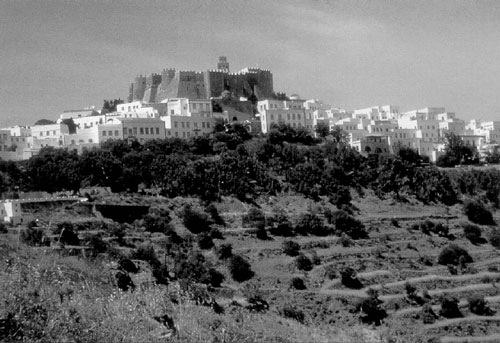
The Monastery of St. John above the modern town of Chora. A cave below the monastery is the traditional site of John’s visions.
What did John see?
The book of Revelation seems to reflect life on the island. Weather phenomena like white clouds (14:14), thunder and lightning (11:19; 14:2), great hail (8:7; 11:19; 16:21) and rainbows (4:3; 10:1) are common. From the peak of Mt. Elias, 269 m (883 ft) above sea level, one has a spectacular view of the Aegean Sea islands to the west and the mountains of Asia Minor (Turkey) to the east. There are at least 22 references to the “sea” in Revelation (4:6; 5:13; 7:1, 2, 3; 8:8, 9; 10:2, 5, 8; 12:12; 13:1; 14:2, 7; 15:2; 16:3; 18:17, 19, 21; 19:6; 20:13; 21:1). J.C. Fitzpatrick, visiting the island in the 1880’s, observed:
The King and I: Exiled To Patmos, Part 2
Joomla! - the dynamic portal engine and content management system
The King and I: Exiled To Patmos, Part 2
Second in a series on the Book of Revelation, this article examines the physical and historical evidence for the Aegean island of Patmos. The author draws from both ancient sources and his own exploration of the island to provide a greater understanding of the Book of Revelation.

Second in a series on the Book of Revelation, this article examines the physical and historical evidence for the Aegean island of Patmos. The author draws from both ancient sources and his own exploration of the island to provide a greater understanding of the Book of Revelation.
A Misconception
A common misconception in commentaries and popular prophetic writings is that the island of Patmos, where John was exiled, was a sort of Alcatraz (Swindoll 1986:3) or St. Helene where Napoleon was exiled (Saffrey 1975:392). This is partly due to 19th-century travelers who described the island as “a barren, rocky, desolate-looking place” (Newton 1865: 223) or as “a wild and barren island” (Geil 1896: 70). Unfortunately, these 19th-century perceptions are not accurate in describing the island in John’s day.

The island of Patmos (Rv 1:9). This small volcanic island sits in the Aegean Sea, 60 km (37 mi) from the Turkish coastal city of Miletus. Here the Apostle John was exiled and received his visions recorded in the Book of Revelation (sometimes called The Revelation of St. John the Divine). This view of the island is from the village of Chora to the northeast. In the center is the ancient and modern harbor, where the modern town of Skela is located. The ancient acropolis, known as Kastelli, is to the left.
First-century Patmos, with its natural protective harbor, was a strategic island on the sea lane from Ephesus to Rome. A large administrative center, outlying villages, a hippodrome (for horse racing), and at least three pagan temples made Patmos hardly an isolated and desolate place!

The harbor of Skela with the ancient acropolis (Kastelli) of Patmos to the right. Located on the sea lane between Rome and Ephesus, the harbor of Patmos was a regular and important stop along the line of communication and commerce between these two cities. Church tradition suggests John was exiled here from the city of Ephesus, where he had been serving as elder.
The 11 km (7 mi) long crescent-shaped island has a jagged 65 km (40 mi) coastline. Pliny the Elder (AD 23–79) knew the island, and in his Natural History said it was 48 km (30 mi) in circumference (Rackham 1989: 169). Central in the island and at its narrowest point is the Kastelli, the ancient administrative center. Called Skela today, it was located behind the harbor, and remains of its 1.2 m (4 ft) wide acropolis wall and three towers can still be seen (Tozar 1889: 194–95; Simpson and Lazenby 1970: 47-52). This center has a commanding view of the harbor, the sea lanes to and from Patmos and, I might add, spectacular sunsets!
Literary sources mention outlying villages on the island that probably engaged in fishing and agricultural activities. Of the three temples, one inscription mentions a temple to Artemis (Diana), the goddess of the hunt. Artemis’ main temple was in Ephesus, and known as one of the seven wonders of the ancient world. Patmos was probably located beneath the Monastery of St. John near the village of Chora. Threshold stones of the iconostasis (partition) in the Chapel of the Virgin may be remains of this temple.

Five courses of stone from the ancient wall surrounding the acropolis at Patmos. From this administrative center, Roman officials had a commanding view of the harbor and sea lanes.
Literary evidence also speaks of a temple to Apollo, brother of Artemis, most likely located near the harbor of Skela. One 19th century traveler mentioned:
at the wharf I observed four or five beautiful white marble columns, cut and carved in true Greek fashion, and once very likely standing in the portico of some splendid temple to a heathen god, now used as mooring posts (Geil 1897:73).
Additional literary sources suggest the island’s third temple, dedicated to Aphrodite the goddess of love and beauty, was probably built on the Kalikatsou Rock along the Patmos shoreline.

Remains of the northeast gate of the acropolis. John probably did not live in this area, which was reserved for military and governmental officials. Apparently free to move about the island, John probably resided in one of the outlying villages. Gordon Franz
A hippodrome on the island, known from inscription but not yet identified, was probably located near modern Skela. Using my sanctified imagination, I wonder if the Apostle John preached to the inhabitants of Patmos in this hippodrome?
Unfortunately, most tourists visiting Patmos today disembark at the port of Skela, hop a bus to the Cave of the Apocalypse, zig to the Monastery of St. John in Chora, zag to the harbor of Skela for shopping and eating before heading back to their cruise ship and out to sea. Yet, there are enough Biblically-significant sites on the island to make a serious student spend a couple of days.
Patmos has been described as a penal colony, like an ancient Alcatraz. Commentators refer to Pliny’s Natural History 4.12.69, yet it says nothing about a penal colony (Sanders 1962-63:76; Hemer 1986:221, n. 1). My impression is that John was exiled to Patmos because of its Artemis/Ephesus connections. The proconsul of Asia Minor wanted John out of Ephesus so he sent him to Patmos, also within his jurisdiction. Hemer suggests the island might be connected with Miletus, 72 km (45 mi) away (1986:28, 222, n. 8).
The length of John’s exile on Patmos differs from tradition to tradition. Most likely it lasted only 18 months, and upon Domitian’s death John was free to return to Ephesus. Dio Cassius wrote,
[Emperor] Nerva also released all who were on trial for maiestas (high treason) and restored the exile (Cary 1995:361).
Eusebius adds:
the sentences of Domitian were annulled, and the Roman Senate decreed the return of those who had been unjustly banished and the restoration of their property...the Apostle John, after his banishment to the island, took up his abode at Ephesus (Lake 1980:241).
Travels of St. John in Patmos
According to church tradition, the book Travels of St. John In Patmos was written by Prochorus (Acts 6:5), secretary to John. Critical scholarship suggests it was written in the fifth century AD. If it is historically reliable, John was only banished to the island, not imprisoned.
Travels of St. John in Patmos makes interesting reading. On the trip to Patmos, a violent storm arose and a passenger was swept into the sea. John prayed and a wave deposited the young man back on the boat. This miracle gave John opportunity to preach the Gospel. Once on Patmos, the Roman governor, Laurentius, set him free.

Kalikatsou Rock is the probable site of a temple to Aphrodite. Note nearby Aegean islands in the distance. John makes reference to these islands (Rv 6:14, 16:20). While called "the most sacred island" of Artemis (Diana of the Ephesians, Acts 19:28), the island housed three temples-to Artemis, her brother Apollo, and Aphrodite. Aphrodite was the goddess of love and beauty.
Laurentius’s father-in-law, Myron, offers the Apostle lodging in his house, and soon Myron’s house became the first church on the island. St. John healed Apollonides, Myron’s son, who was possessed with the devil, and this miracle led to the conversion of both Chrysippe, myron’s daughter, and her husband, the Roman governor (Meinardus 1979:7).
Also recorded in Travels of St. John in Patmos is a spiritual confrontation between John and Kynops, a famous magician on the island. John was victorious and Kynops drowned in the harbor. The event is commemorated by a church today (Meinardus 1979:9). Consequently, the people of the island turned to the Lord. Before leaving Patmos, John was asked by the believers to write an account of the life of the Lord Jesus. This was the Gospel of John according to one tradition. While the historicity of these accounts is in doubt, such freedom of movement on the island is hinted at in the book of Revelation.

The Monastery of St. John above the modern town of Chora. A cave below the monastery is the traditional site of John’s visions.
What did John see?
The book of Revelation seems to reflect life on the island. Weather phenomena like white clouds (14:14), thunder and lightning (11:19; 14:2), great hail (8:7; 11:19; 16:21) and rainbows (4:3; 10:1) are common. From the peak of Mt. Elias, 269 m (883 ft) above sea level, one has a spectacular view of the Aegean Sea islands to the west and the mountains of Asia Minor (Turkey) to the east. There are at least 22 references to the “sea” in Revelation (4:6; 5:13; 7:1, 2, 3; 8:8, 9; 10:2, 5, 8; 12:12; 13:1; 14:2, 7; 15:2; 16:3; 18:17, 19, 21; 19:6; 20:13; 21:1). J.C. Fitzpatrick, visiting the island in the 1880’s, observed:


